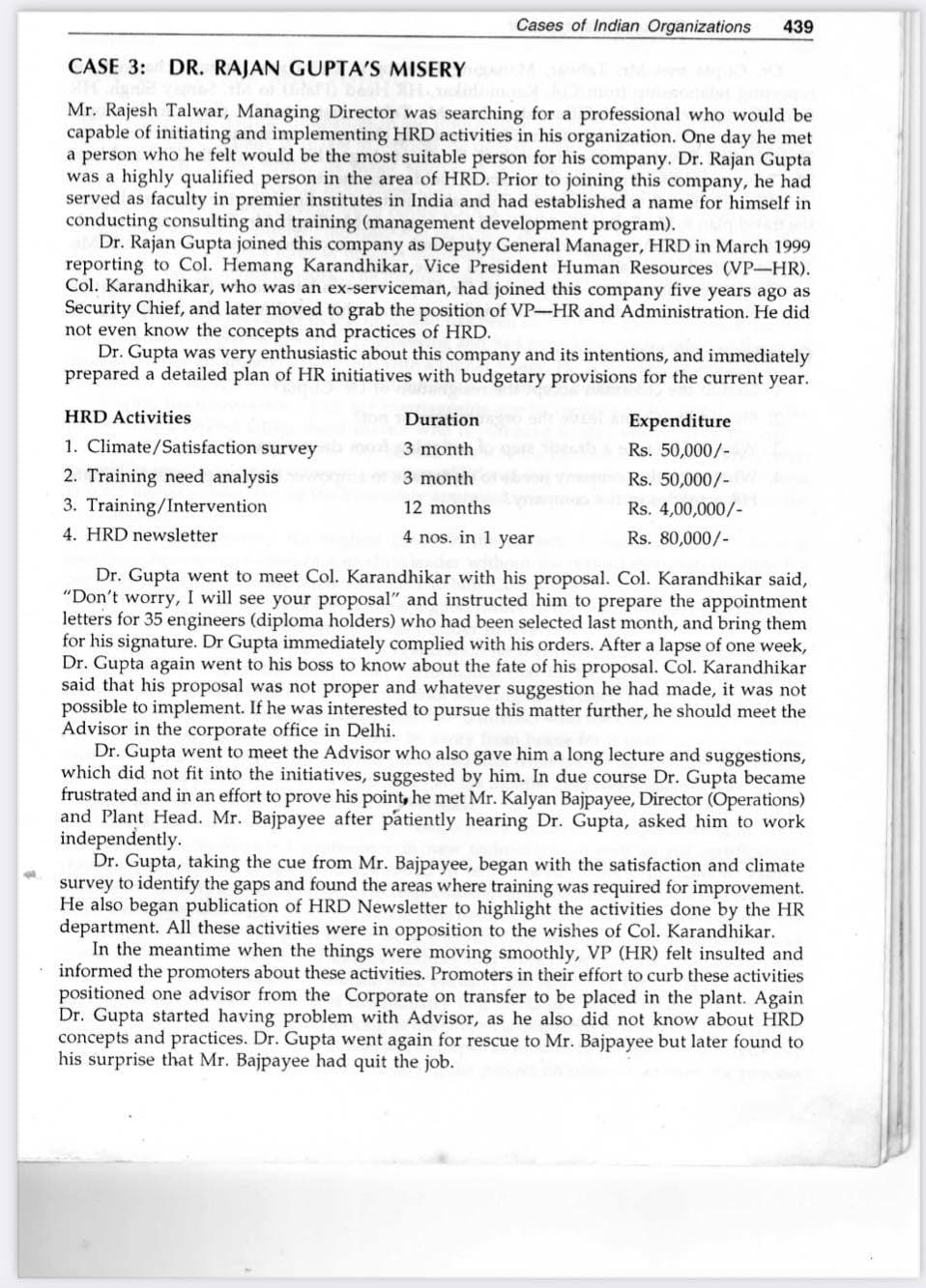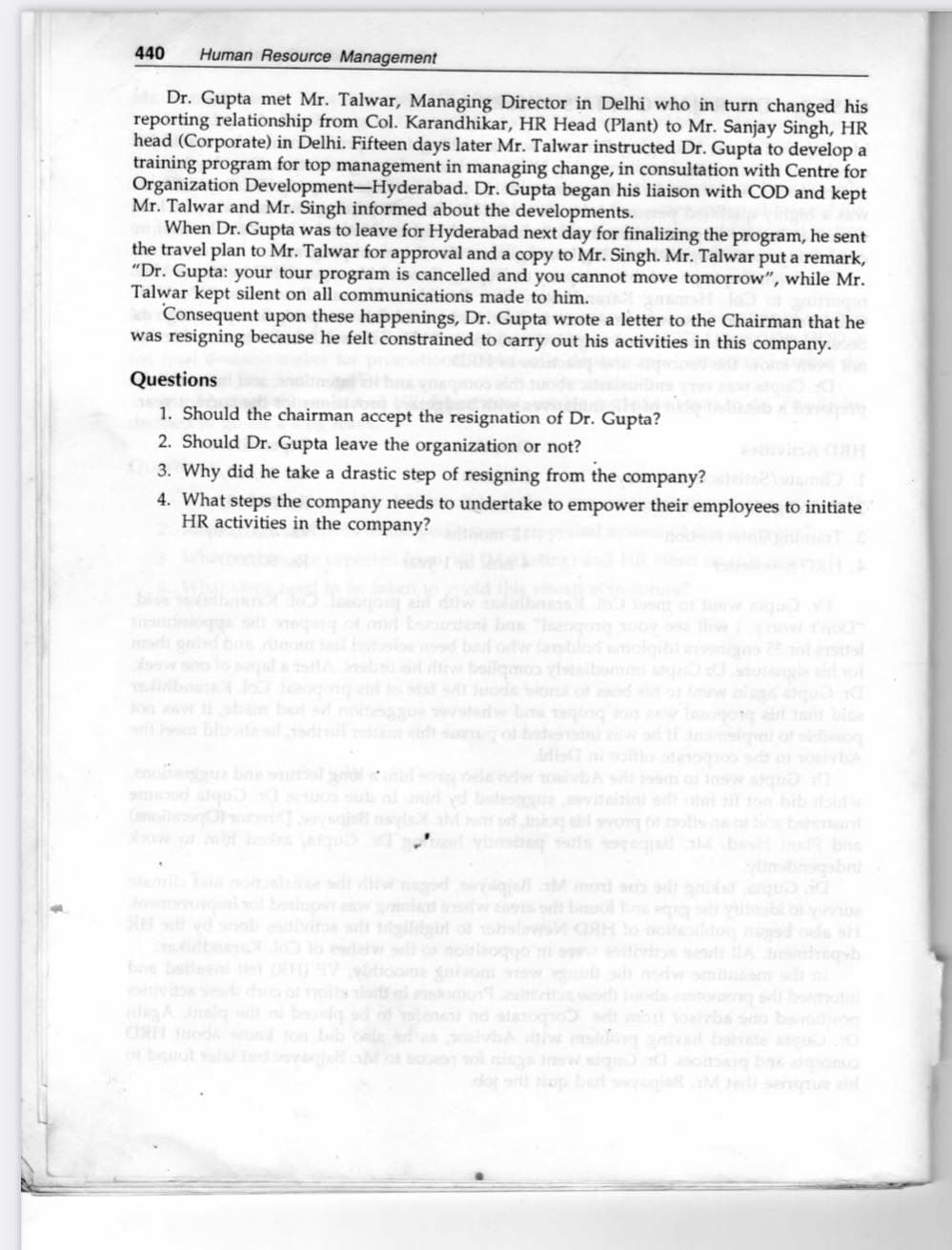QUESTION : 1. Should the chairman accept the resignation of Dr. Gupta? 2. Should Dr. Gupta leave the organization or not?
QUESTION : 1. Should the chairman accept the resignation of Dr. Gupta? 2. Should Dr. Gupta leave the organization or not?
Management, Loose-Leaf Version
13th Edition
ISBN:9781305969308
Author:Richard L. Daft
Publisher:Richard L. Daft
Chapter12: Managing Human Talent
Section: Chapter Questions
Problem 1SGB
Related questions
Question
Read the case carefully and answer the questions.
QUESTION :
1. Should the chairman accept the resignation of Dr. Gupta?
2. Should Dr. Gupta leave the organization or not?

Transcribed Image Text:Cases of Indian Organizations
439
CASE 3:
DR. RAJAN GUPTA'S MISERY
Mr. Rajesh Talwar, Managing Director was searching for a professional who would be
capable of initiating and implementing HRD activities in his organization. One day he met
a person who he felt would be the most suitable person for his company. Dr. Rajan Gupta
was a highly qualified person in the area of HRD. Prior to joining this company, he had
served as faculty in premier institutes in India and had established a name for himself in
conducting consulting and training (management development program).
Dr. Rajan Gupta joined this company as Deputy General Manager, HRD in March 1999
reporting to Col. Hemang Karandhikar, Vice President Human Resources (VP-HR).
Col. Karandhikar, who was an ex-serviceman, had joined this company five years ago as
Security Chief, and later moved to grab the position of VP-HR and Administration. He did
not even know the concepts and practices of HRD.
Dr. Gupta was very enthusiastic about this company and its intentions, and immediately
prepared a detailed plan of HR initiatives with budgetary provisions for the current year.
HRD Activities
Duration
Expenditure
1. Clima
/Satisfaction survey
rol3 month
Rs. 50,000/-
2. Training need analysis
3 month
Rs. 50,000/-
3. Training/Intervention
12 months
Rs. 4,00,000/-
4. HRD newsletter
4 nos. in 1 year
Rs. 80,000/-
Dr. Gupta went to meet Col. Karandhikar with his proposal. Col. Karandhikar said,
"Don't worry, I will see your proposal" and instructed him to prepare the appointment
letters for 35 engineers (diploma holders) who had been selected last month, and bring them
for his signature. Dr Gupta immediately complied with his orders. After a lapse of one week,
Dr. Gupta again went to his boss to know about the fate of his proposal. Col. Karandhikar
said that his proposal was not proper and whatever suggestion he had made, it was not
possible to implement. If he was interested to pursue this matter further, he should meet the
Advisor in the corporate office in Delhi.
Dr. Gupta went to meet the Advisor who also gave him a long lecture and suggestions,
which did not fit into the initiatives, suggested by him. In due course Dr. Gupta became
frustrated and in an effort to prove his point, he met Mr. Kalyan Bajpayee, Director (Operations)
and Plant Head. Mr. Bajpayee after patiently hearing Dr. Gupta, asked him to work
independently.
Dr. Gupta, taking the cue from Mr. Bajpayee, began with the satisfaction and climate
survey to identify the gaps and found the areas where training was required for improvement.
He also began publication of HRD Newsletter to highlight the activities done by the HR
department. All these activities were in opposition to the wishes of Col. Karandhikar.
In the meantime when the things were moving smoothly, VP (HR) felt insulted and
informed the promoters about these activities. Promoters in their effort to curb these activities
positioned one advisor from the Corporate on transfer to be placed in the plant. Again
Dr. Gupta started having problem with Advisor, as he also did not know about HRD
concepts and practices. Dr. Gupta went again for rescue to Mr. Bajpayee but later found to
his surprise that Mr. Bajpayee had quit the job.

Transcribed Image Text:440
Human Resource Management
Dr. Gupta met Mr. Talwar, Managing Director in Delhi who in turn changed his
reporting relationship from Col. Karandhikar, HR Head (Plant) to Mr. Sanjay Singh, HR
head (Corporate) in Delhi. Fifteen days later Mr. Talwar instructed Dr. Gupta to develop a
training program for top management in managing change, in consultation with Centre for
Organization Development-Hyderabad. Dr. Gupta began his liaison with COD and kept
Mr. Talwar and Mr. Singh informed about the developments.
When Dr. Gupta was to leave for Hyderabad next day for finalizing the program, he sent
the travel plan to Mr. Talwar for approval and a copy to Mr. Singh. Mr. Talwar put a remark,
"Dr. Gupta: your tour program is cancelled and you cannot move tomorrow", while Mr.
Talwar kept silent on all communications made to him.
Consequent upon these happenings, Dr. Gupta wrote a letter to the Chairman that he
was resigning because he felt constrained to carry out his activities in this company.
Questions
1. Should the chairman accept the resignation of Dr. Gupta?
2. Should Dr. Gupta leave the organization or not?
3. Why did he take a drastic step of resigning from the company?
4. What steps the company needs to undertake to empower their employees to initiate
HR activities in the company?
en bos
d bl ortw
mdi gd b
bne I
golbe
elendw
vA m o
eviteitin
n long ol
t vi s e b
eg
slew M GRH
b betleen
nvo w
milm
eA nel w
CRH ods b
no slaoo
oba b
wgo o g bas on
do bet M sene
Expert Solution
This question has been solved!
Explore an expertly crafted, step-by-step solution for a thorough understanding of key concepts.
Step by step
Solved in 3 steps

Recommended textbooks for you

Management, Loose-Leaf Version
Management
ISBN:
9781305969308
Author:
Richard L. Daft
Publisher:
South-Western College Pub

Understanding Management (MindTap Course List)
Management
ISBN:
9781305502215
Author:
Richard L. Daft, Dorothy Marcic
Publisher:
Cengage Learning

Management, Loose-Leaf Version
Management
ISBN:
9781305969308
Author:
Richard L. Daft
Publisher:
South-Western College Pub

Understanding Management (MindTap Course List)
Management
ISBN:
9781305502215
Author:
Richard L. Daft, Dorothy Marcic
Publisher:
Cengage Learning